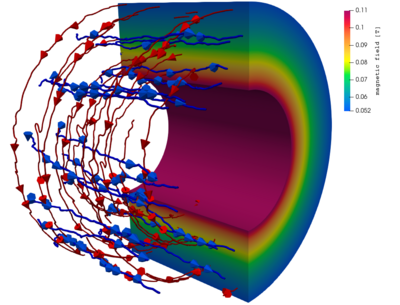Computational Particle-in-Cell modelling for Plasma Flow

Plasma is the most abundant state of matter in the universe, it consist of ionized atoms or molecules and free electrons. Compared to ordinary matter it has some special properties, among other there exist long-ranging attraction and repulsion of charges through electrostatic forces, from which a verity of other fascinating effects emerge. Next to the experimental observation and measuring of plasma in laboratory settings exist the computational simulation of plasma using a variety of methods, one of which is the modeling as fluid using magneto-hydrodynamics . Another method is the so called Particle-in-Cell method, which uses discrete particles moving on trajectories which are influenced by electro-magnetic fields computed on an numerical grid and collisions that may occur with other particles. Thus this method is of statistical nature, which requires the averaging of a multitude particles over several simulation time steps to acquire macroscopic properties like the conductivity of the plasma. Thereby compared to other methods, using particles to simulate plasma is computational expansive, however, it allows for a more precise view on the plasma behavior and its properties. In continuum approaches like magneto-hydrodynamics properties like the conductivity are prescribed to the simulation using theoretical model, while in the Particle-in-Cell method the property emerges from the distribution and state of the particles.
Using in-house developed open-source software, the Particle-in-Cell method is used for the simulation of electric discharge in plasma devices like thermal electric arc-jet thrusters. Which allow for a study on the behavior of the arc and consequential development of more accurate models for the simulation with different computational methods.
Additionally, the study of the motion of charged species in magnetic fields bears the potential to gain new insights into the to this day not completely understood behavior of electrons in hall thrusters. Here, electrons move in higher numbers across magnetic field lines, than can be explained by classical theories.


 "
"